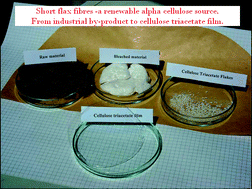Alpha cellulose from industrial and agricultural renewable sources like short flax fibres, ears of corn and wheat-straw and its transformation into cellulose acetates†
Abstract
Cellulose with high content of alpha cellulose (ca. 98%, named CF) was extracted from short flax fibres following a free chloride procedure based on a two-step oxidative approach. The same procedure provided celluloses with alpha cellulose content around 83% from ears of corn (CC) and wheat straw (CW). CF can be used for the preparation of cellulose triacetate (CTA) and diacetate (CA), while both CC and CW can be used for the preparation of CA. The

- This article is part of the themed collection: Green materials

 Please wait while we load your content...
Please wait while we load your content...